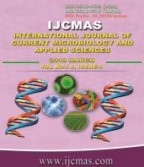


 National Academy of Agricultural Sciences (NAAS)
National Academy of Agricultural Sciences (NAAS)

|
PRINT ISSN : 2319-7692
Online ISSN : 2319-7706 Issues : 12 per year Publisher : Excellent Publishers Email : editorijcmas@gmail.com / submit@ijcmas.com Editor-in-chief: Dr.M.Prakash Index Copernicus ICV 2018: 95.39 NAAS RATING 2020: 5.38 |
Superficial mycoses are the most frequent forms of human infections, Dermatophytes affecting more than 20 to 25% of the world’s population. They are predominantly caused by the keratinophilic fungi in the genera of Trichophyton, Microsporum and Epidermophyton. 1. Isolation and identification of Dermatophytes causing skin, hair and nail infections. 2. To know the prevalence of Dermatophytic infections in Tertiary care hospital. This study was conducted from April 2018 to July 2018 in Department of Microbiology, J. J. M. Medical College, Davanagere. From 221 clinically suspected Dermatophytosis cases 72 skin scrapings, 2 hair samples and 147 nail clippings were collected according to standard procedure. All samples were subjected to direct microscopy in KOH and culture on Sabouraud’s dextrose agar with cycloheximide. In case of growth, etiological agents were confirmed by the characteristic morphology of the colony and by studying the microscopic appearance of the fungus on Lacto Phenol Cotton Blue (LPCB) mount and slide culture. Out of 221 cases, Males 137(61.9%) and Females 84(38%) and majority were in age group of 31 to 40 years (45.6%). Among 221 samples, 145 isolates were isolated. 149(67.4%) samples were positive by KOH mount and 145(65.6%) were positive by culture. Dermatophytes were grown in 145(65.6%) isolates. Among Dermatophytes, Trichophyton rubrum 68(46.9%) was most commonly isolated species followed by Trichophyton mentagrophytes 39(26.9%), Microsporum gypseum 22(15.2%), Epidermophyton floccosum 13(8.9%) and Trichophyton tonsurans 3(2.1%). Dermatophytosis is the common superficial fungal infection among males and around age group of 31 to 40 years. Trichophyton rubrum remains the most common etiological agent. Hence clinic-epidemiological data is helpful for creating public awareness and for development of diagnostic, preventive and treatment strategies.
 |
 |
 |
 |
 |